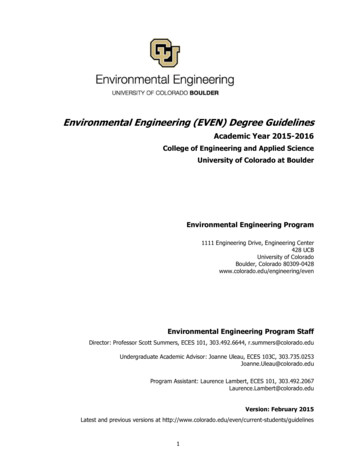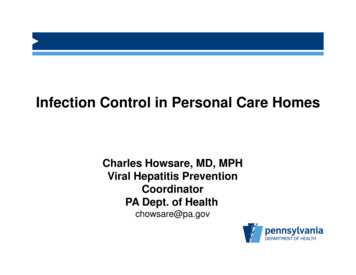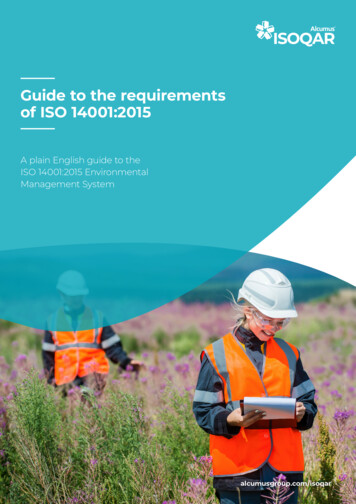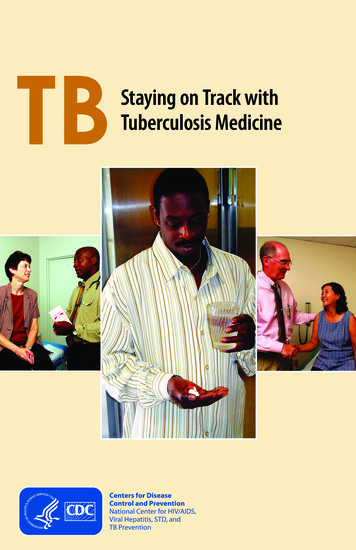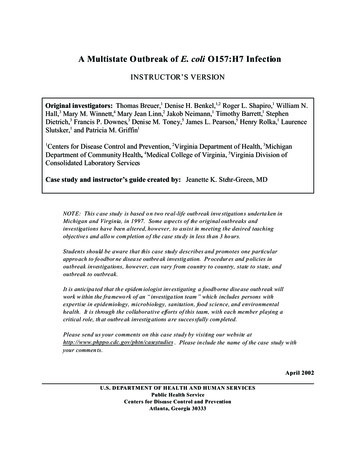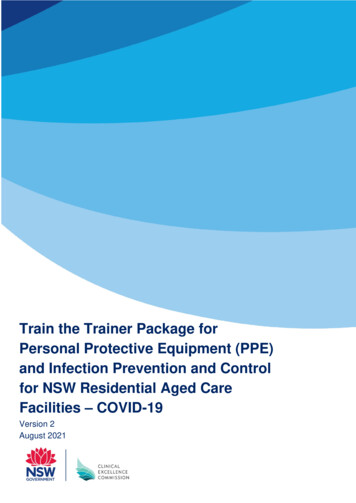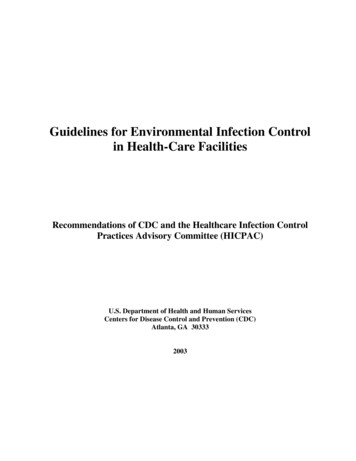
Transcription
Guidelines for Environmental Infection Controlin Health-Care FacilitiesRecommendations of CDC and the Healthcare Infection ControlPractices Advisory Committee (HICPAC)U.S. Department of Health and Human ServicesCenters for Disease Control and Prevention (CDC)Atlanta, GA 303332003
Suggested Citations:Available from the CDC Internet Site:The full-text version of the guidelines appears as a web-based document at the CDC’sDivision of Healthcare Quality Promotion’s Internet site at:www.cdc.gov/ncidod/hip/enviro/guide.htmThe full-text version of the guidelines should be cited when reference is made primarily tomaterial in Parts I and IV. The print version of the guidelines appears as:Sehulster LM, Chinn RYW, Arduino MJ, Carpenter J, Donlan R, Ashford D, Besser R,Fields B, McNeil MM, Whitney C, Wong S, Juranek D, Cleveland J. Guidelines forenvironmental infection control in health-care facilities. Recommendations from CDC andthe Healthcare Infection Control Practices Advisory Committee (HICPAC). Chicago IL;American Society for Healthcare Engineering/American Hospital Association; 2004.Part II of these guidelines appeared in the CDC’s “Morbidity and MortalityWeekly Report:”Centers for Disease Control and Prevention. Guidelines for environmental infection control inhealth-care facilities: recommendations of CDC and the Healthcare Infection Control PracticesAdvisory Committee (HICPAC). MMWR 2003; 52 (No. RR-10): 1–48.Updates to the Part II recommendations also appeared in the MMWR in 2003 as “Errata: Vol.52 (No. RR-10)” (MMWR Vol. 52 [42]: 1025–6) on October 24, 2003 and as a “Notice toReaders” scheduled to appear in February 2004. The full-text version of these guidelines (thisdocument) incorporates these updates.
iCenters for Disease Control and PreventionHealthcare Infection Control Practices AdvisoryCommittee (HICPAC)Guidelines for Environmental Infection Control inHealth-Care FacilitiesAbstractBackground:Although the environment serves as a reservoir for a variety of microorganisms, it is rarely implicated indisease transmission except in the immunocompromised population. Inadvertent exposures toenvironmental opportunistic pathogens (e.g., Aspergillus spp. and Legionella spp.) or airbornepathogens (e.g., Mycobacterium tuberculosis and varicella-zoster virus) may result in infections withsignificant morbidity and/or mortality. Lack of adherence to established standards and guidance (e.g.,water quality in dialysis, proper ventilation for specialized care areas such as operating rooms, andproper use of disinfectants) can result in adverse patient outcomes in health-care facilities.Objective:The objective is to develop an environmental infection-control guideline that reviews and reaffirmsstrategies for the prevention of environmentally-mediated infections, particularly among health-careworkers and immunocompromised patients. The recommendations are evidence-based wheneverpossible.Search Strategies:The contributors to this guideline reviewed predominantly English-language articles identified fromMEDLINE literature searches, bibliographies from published articles, and infection-control textbooks.Criteria for Selecting Citations and Studies for This Review:Articles dealing with outbreaks of infection due to environmental opportunistic microorganisms andepidemiological- or laboratory experimental studies were reviewed. Current editions of guidelines andstandards from organizations (i.e., American Institute of Architects [AIA], Association for theAdvancement of Medical Instrumentation [AAMI], and American Society of Heating, Refrigeration,and Air-Conditioning Engineers [ASHRAE]) were consulted. Relevant regulations from federalagencies (i.e., U.S. Food and Drug Administration [FDA]; U.S. Department of Labor, OccupationalSafety and Health Administration [OSHA]; U.S. Environmental Protection Agency [EPA]; and U.S.Department of Justice) were reviewed. Some topics did not have well-designed, prospective studies norreports of outbreak investigations. Expert opinions and experience were consulted in these instances.Types of Studies:Reports of outbreak investigations, epidemiological assessment of outbreak investigations with controlstrategies, and in vitro environmental studies were assessed. Many of the recommendations are derived
iifrom empiric engineering concepts and reflect industry standards. A few of the infection-controlmeasures proposed cannot be rigorously studied for ethical or logistical reasons.Outcome Measures:Infections caused by the microorganisms described in this guideline are rare events, and the effect ofthese recommendations on infection rates in a facility may not be readily measurable. Therefore, thefollowing steps to measure performance are suggested to evaluate these recommendations:1. Document whether infection-control personnel are actively involved in all phases of a healthcare facility’s demolition, construction, and renovation. Activities should include performing arisk assessment of the necessary types of construction barriers, and daily monitoring anddocumenting of the presence of negative airflow within the construction zone or renovationarea.2. Monitor and document daily the negative airflow in airborne infection isolation rooms (AII) andpositive airflow in protective environment rooms (PE), especially when patients are in theserooms.3. Perform assays at least once a month by using standard quantitative methods for endotoxin inwater used to reprocess hemodialyzers, and for heterotrophic, mesophilic bacteria in water usedto prepare dialysate and for hemodialyzer reprocessing.4. Evaluate possible environmental sources (e.g., water, laboratory solutions, or reagents) ofspecimen contamination when nontuberculous mycobacteria (NTM) of unlikely clinicalimportance are isolated from clinical cultures. If environmental contamination is found,eliminate the probable mechanisms.5. Document policies to identify and respond to water damage. Such policies should result ineither repair and drying of wet structural materials within 72 hours, or removal of the wetmaterial if drying is unlikely within 72 hours.Main Results:Infection-control strategies and engineering controls, when consistently implemented, are effective inpreventing opportunistic, environmentally-related infections in immunocompromised populations.Adherence to proper use of disinfectants, proper maintenance of medical equipment that uses water(e.g., automated endoscope reprocessors and hydrotherapy equipment), water-quality standards forhemodialysis, and proper ventilation standards for specialized care environments (i.e., airborne infectionisolation [AII], protective environment [PE], and operating rooms [ORs]), and prompt management ofwater intrusion into facility structural elements will minimize health-care–associated infection risks andreduce the frequency of pseudo-outbreaks. Routine environmental sampling is not advised except in thefew situations where sampling is directed by epidemiologic principles and results can be applieddirectly to infection control decisions, and for water quality determinations in hemodialysis.Reviewers’ Conclusions:Continued compliance with existing environmental infection control measures will decrease the risk ofhealth-care–associated infections among patients, especially the immunocompromised, and health-careworkers.
iiiCenters for Disease Control and PreventionHealthcare Infection Control Practices Advisory Committee (HICPAC)Guidelines for Environmental Infection Control inHealth-Care FacilitiesTable of ContentsExecutive Summary. 1Part I. Background Information: Environmental Infection Control in Health-CareFacilities. 3A. Introduction. 3B. Key Terms Used in this Guideline . 5C. Air. 61. Modes of Transmission of Airborne Diseases. 62. Airborne Infectious Diseases in Health-Care Facilities. 73. Heating, Ventilation, and Air Conditioning Systems in Health-Care Facilities . 134. Construction, Renovation, Remediation, Repair, and Demolition . 215. Environmental Infection-Control Measures for Special Health-Care Settings. 346. Other Aerosol Hazards in Health-Care Facilities . 40D. Water. 401. Modes of Transmission of Waterborne Diseases . 402. Waterborne Infectious Diseases in Health-Care Facilities . 413. Water Systems in Health-Care Facilities . 464. Strategies for Controlling Waterborne Microbial Contamination . 535. Cooling Towers and Evaporative Condensers. 576. Dialysis Water Quality and Dialysate. 597. Ice Machines and Ice . 658. Hydrotherapy Tanks and Pools. 679. Miscellaneous Medical/Dental Equipment Connected to Main Water Systems . 69E. Environmental Services . 711. Principles of Cleaning and Disinfecting Environmental Surfaces. 712. General Cleaning Strategies for Patient-Care Areas. 743. Cleaning Strategies for Spills of Blood and Body Substances . 774. Carpeting and Cloth Furnishings . 785. Flowers and Plants in Patient-Care Areas . 806. Pest Control . 817. Special Pathogen Concerns. 82F. Environmental Sampling . 881. General Principles: Microbiologic Sampling of the Environment . 882. Air Sampling. 893. Water Sampling . 944. Environmental Surface Sampling . 95G. Laundry and Bedding. 981. General Information . 982. Epidemiology and General Aspects of Infection Control. 983. Collecting, Transporting, and Sorting Contaminated Textiles and Fabrics. 99
iv4. Parameters of the Laundry Process . 1005. Special Laundry Situations. 1026. Surgical Gowns, Drapes, and Disposable Fabrics. 1037. Antimicrobial-Impregnated Articles and Consumer Items Bearing Antimicrobial Labeling . 1038. Standard Mattresses, Pillows, and Air-Fluidized Beds . 104H. Animals in Health-Care Facilities . 1051. General Information . 1052. Animal-Assisted Activities, Animal-Assisted Therapy, and Resident Animals . 1063. Service Animals . 1084. Animals as Patients in Human Health-Care Facilities . 1105. Research Animals in Health-Care Facilities . 111I. Regulated Medical Waste . 1121. Epidemiology . 1122. Categories of Medical Waste . 1123. Management of Regulated Medical Waste in Health-Care Facilities . 1134. Treatment of Regulated Medical Waste. 1135. Discharging Blood, Fluids to Sanitary Sewers or Septic Tanks. 1166. Medical Waste and CJD. 116Part II. Recommendations for Environmental Infection Control in Health-Care Facilities. 117A. Rationale for Recommendations . 117B. Rating Categories. 117C. Recommendations—Air . 118D. Recommendations—Water . 125E. Recommendations—Environmental Services . 133F. Recommendations—Environmental Sampling . 138G. Recommendations—Laundry and Bedding . 138H. Recommendations—Animals in Health-Care Facilities. 141I. Recommendations—Regulated Medical Waste. 143Part III. References. 145Part IV. Appendices. 201Appendix A. Glossary of Terms . 201Appendix B. Air . 2101. Airborne Contaminant Removal . 2102. Air Sampling for Aerosols Containing Legionellae. 2103. Calculation of Air Sampling Results. 2114. Ventilation Specifications for Health-Care Facilities. 212Appendix C. Water. 2201. Biofilms. 2202. Water and Dialysate Sampling Strategies in Dialysis . 2223. Water Sampling Strategies and Culture Techniques for Detecting Legionellae . 2234. Procedure for Cleaning Cooling Towers and Related Equipment . 2255. Maintenance Procedures Used to Decrease Survival and Multiplications of Legionella spp. inPotable-Water Distribution Systems . 227Appendix D. Insects and Microorganisms. 228Appendix E. Information Resources. 229Appendix F. Areas of Future Research . 230Index—Parts I and IV . 231
vList of Figures, Boxes, and TablesFiguresFigure 1. Diagram of a ventilation system . 14Figure 2. Example of positive-pressure room control for protection from airborne environmentalmicrobes (PE) . 35Figure 3. Example of negative-pressure room control for airborne infection isolation (AII) . 36Figure 4. Example of airborne infection isolation (AII) room with anteroom and neutral anteroom . 37Figure 5. Diagram of a typical air conditioning (induced draft) cooling tower . 58Figure 6. Dialysis water treatment system . 60BoxesBox 1. Environmental infection control: performance measures . 2Box 2. Eight criteria for evaluating the strength of evidence for environmental sources of infection. 4Box 3. Chain of infection components . 4Box 4. Suggested members and functions of a multi-disciplinary coordination team for construction,renovation, repair, and demolition projects . 24Box 5. Construction design and function considerations for environmental infection control . 25Box 6. Unresolved issues associated with microbiologic air sampling. 28Box 7. Construction/repair projects that require barrier structures . 32Box 8. Strategy for managing TB patients and preventing airborne transmission in operating rooms. 39Box 9. Recovery and remediation measures for water-related emergencies. 52Box 10. Contingency planning for flooding. 53Box 11. Steps in an epidemiologic investigation for legionellosis. 56Box 12. General steps for cleaning and maintaining ice machines, dispensers, and storage chests . 66Box 13. Preliminary concerns for conducting air sampling . 90Box 14. Selecting an air sampling device . 93Box 15. Undertaking environmental-surface sampling. 95Box C.1. Potential sampling sites for Legionella spp. in health-care facilities . 224Box C.2. Procedures for collecting and processing environmental specimens for Legionella spp. 225TablesTable 1. Clinical and epidemiologic characteristics of aspergillosis. 7Table 2. Environmental fungal pathogens: entry into and contamination of the health-care facility. 8Table 3. Clinical and epidemiologic characteristics of tuberculosis (TB). 10Table 4. Microorganisms associated with airborne transmission. 13Table 5. Filtration methods . 15Table 6. Engineered specifications for positive- and negative pressure rooms. 19Table 7. Ventilation hazards in health-care facilities that may be associated with increased potential ofairborne disease transmission . 22Table 8. Strategies to reduce dust and moisture intrusion during external demolition and construction 30
viTable 9. Infection-control measures for internal construction and repair projects . 32Table 10. Summary of ventilation specifications in selected areas of health-care facilities. 39Table 11. Clinical and epidemiologic characteristics of legionellosis/Legionnaires disease. 41Table 12. Pseudomonas aeruginosa infections in health-care facilities . 42Table 13. Other gram-negative bacteria associated with water and moist environments . 43Table 14. Nontuberculous mycobacteria—environmental vehicles . 45Table 15. Water and point-of-use fixtures as sources and reservoirs of waterborne pathogens . 47Table 16. Water demand in health-care facilities during water disruption emergencies . 50Table 17. Additional infection-control measures to prevent exposure of high-risk patients to waterbornepathogens. 57Table 18. Microbiologic limits for hemodialysis fluids. 62Table 19. Factors influencing microbial contamination in hemodialysis systems. 63Table 20. Microorganisms and their sources in ice and ice machines . 65Table 21. Infections associated with use of hydrotherapy equipment . 67Table 22. Levels of disinfection by type of microorganism . 72Table 23. Air sampling methods and examples of equipment . 91Table 24. Examples of eluents and diluents for environmental-surface sampling. 96Table 25. Methods of environmental-surface sampling. 97Table 26. Examples of diseases associated with zoonotic transmission . 105Table 27. Microorganisms and biologicals identified as select agents . 115Table B.1. Air changes/hour (ACH) and time required for airborne-contaminant removal efficiencies of99% and 99.9% . 210Table B.2. Ventilation requirements for areas affecting patient care in hospitals and outpatient facilities. 212Table B.3. Pressure relationships and ventilation of certain areas of nursing facilities. 217Table B.4. Filter efficiencies for central ventilation and air conditioning systems in general hospitals. 219Table B.5. Filter efficiencies for central ventilation and air conditioning systems in outpatient facilities. 219Table B.6. Filter efficiencies for central ventilation and air conditioning systems in nursing facilities. 220Table B.7. Filter efficiencies for central ventilation and air conditioning systems in psychiatric hospitals. 220Table D.1. Microorganisms isolated from arthropods in health-care settings . 228
viiList of Abbreviations Used in This OPDOTECELISAEPAESRDanimal-assisted activityAssociation for the Advancement of Medical Instrumentationanimal-assisted therapyAmerican Council of Governmental Industrial Hygienistsair changes per hourAmericans with Disabilities Actautomated endoscope reprocessoracid-fast bacilliAmerican Hospital Associationauthorities having jurisdictionAmerican Institute of Architectsairborne infection isolationamphotericin Babsolute neutrophil countAmerican National Standards InstituteAssociation of periOperative Registered NursesAmerican Society for Healthcare EngineeringAmerican Society of Heating, Refirgeration, and Air-Conditioning EngineersBacille Calmette-Guérinbuffered charcoal yeast extract mediumbrain-heart infusionCDC/NIH publication “Biosafety in Microbiological and Biomedical Laboratories”biological oxygen demandbovine spongiform encephalopathybiosafety levelCentigradecontinuous ambulatory peritoneal dialysiscontinual cycling peritoneal dialysiscount median aerodynamic diameterU.S. Centers for Disease Control and PreventionCode of Federal Regulationscolony-forming unitCreutzfeldt-Jakob diseasecentimeterU.S. Centers for Medicare and Medicaid Servicescompliance document (OSHA)cooling tower/evaporative condenserdirect fluorescence assay; direct fluorescent antibodyU.S. Department of Health and Human Servicesduck hepatitis B virusdeoxyribonucleic aciddioctylphthalateU.S. Department of Transportationenvironment of care (JCAHO)enzyme-linked immunosorbent assayU.S. Environmental Protection Agencyend-stage renal disease
IOSHnmNNISNTMOPLOSHAPaPCPendotoxin unitFahrenheitU.S. Food and Drug AdministrationFederal Insecticide, Fungicide, and Rodenticide Actfree residual chlorinefoot (feet)U.S. Federal Trade Commissionglycopeptide intermediate resistant Staphylococcus aureushepatitis B virushepatitis C virushigh efficiency particulate airHealthcare Infection Control Practices Advisory Committeehuman immunodeficiency virushuman papilloma virushematopoietic stem cell transplantheating, ventilation, air conditioninginfection control risk assessmentintensive care unit50% median infectious doseintermittent peritoneal dialysisJoint Commission on Accreditation of Healthcare OrganizationskilogramliterMycobacterium avium complex; also used to denote MacConkey agarmultiple-drug resistant organismminimum inhibitory concentrationmicrometer; micronmilliliterminutemilligrammass median aerodynamic diameter“Morbidity and Mortality Weekly Report”methicillin-resistant Staphylococcus aureusmaterial safety data sheetNormalsodium chloridesodium hydroxideNational Center for Infectious DiseasesNational Center for Chronic Disease Prevention and Health PromotionNational Committ
Sehulster LM, Chinn RYW, Arduino MJ, Carpenter J, Donlan R, Ashford D, Besser R, Fields B, McNeil MM, Whitney C, Wong S, Juranek D, Cleveland J. Guidelines for environmental infection control in health-care facilities. Recommendations from CDC and the Healthcare Infection Control Practices Advisory Committee (HICPAC). Chicago IL;



